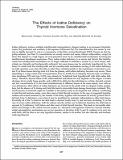Por favor, use este identificador para citar o enlazar a este item:
http://hdl.handle.net/10261/24672COMPARTIR / EXPORTAR:
 SHARE SHARE
 CORE
BASE CORE
BASE
|
|
| Visualizar otros formatos: MARC | Dublin Core | RDF | ORE | MODS | METS | DIDL | DATACITE | |

| Título: | The effects of iodine deficiency on thyroid hormone deiodination |
Autor: | Obregón, María Jesús CSIC ORCID ; Escobar del Rey, Francisco; Morreale de Escobar, Gabriella CSIC | Fecha de publicación: | ago-2005 | Editor: | Mary Ann Liebert | Citación: | Thyroid 15(8): 917-929 (2005) | Resumen: | Iodine deficiency induces multiple intrathyroidal autoregulatory changes leading to an increased triiodothyronine (T(3)) production and secretion, at the expense of thyroxine (T(4)). It is characterized by low serum T(4), normal or slightly elevated T(3), and as a consequence of the latter, normal thyrotropin (TSH). Tissues are also hypothyroxinemic, but their T(3) concentrations are mostly normal and ensure clinical euthyroidism, except for those that depend to a high degree on local generation from T(4) by extrathyroidal mechanisms involving the iodothyronine deiodinases isoenzymes. Thus, unless iodine deficiency is so severe and chronic that intrathyroidal and extrathyroidal mechanisms are no longer sufficient to maintain a normal T(3) in most tissues, individuals are clinically and biochemically euthyroid, but some tissues may be selectively hypothyroid (i.e., the brain). In adults both the intrathyroidal and the extrathyroidal mechanisms reacting to the iodine deficiency are fully operative even when the latter is mild. They contribute jointly to the maintenance of elevated or normal T(3) in those tissues deriving most of it from the plasma, until iodine deficiency becomes very severe. Those depending to a large extent from local generation from T(4), mostly by an interplay between type 2 iodothyronine deiodinase (D2) and type 3 (D3), may already be T(3)-deficient (and hypothyroid) with mild iodine deficiency. Therefore, thyroid status of the iodine-deficient individual not only depends on the degree of iodine shortage, but is mostly tissue-specific, and is difficult to define for the individual as a whole: elevated, normal, and low concentrations of T(3) are found simultaneously in different tissues of the same animal, even with severe deficiencies. Most effects of iodine deficiency are reversed in the adults with an adequate iodine prophylaxis, but the absence of T(4) during early fetal life leads to irreversible brain damage (neurologic cretinism). Thyroid hormones of maternal origin are available to the embryo early in development and continue contributing to fetal thyroid hormone status, even after onset of fetal thyroid secretion. In the case of congenital hypothyroidism and normal maternal T(4), the transfer of the latter, together with increased D2 activity, protects the fetal brain from T(3) deficiency, even when it may be insufficient to maintain euthyroidism in other fetal tissues. Practically all of the T(3) found in the fetal brain is derived locally from T(4), and not from circulating T(3). In the case of severe iodine deficiency, both the embryo and the mother are T(4)-deficient; therefore, the fetal brain is exposed to T(3)-deficiency, both before and after onset of fetal thyroid function. This leads to irreversible alterations and damage to the central nervous system (i.e. abnormal corticogenesis). Moreover, because intrathyroidal autoregulatory mechanisms are not yet operative in the fetus, both T(4) and T(3) continue to be very low until birth, and the fetus is not only hypothyroxinemic, similar to its mother, but also clinically and biochemically hypothyroid. | Descripción: | 13 pages, 7 figures. | Versión del editor: | http://dx.doi.org/10.1089/thy.2005.15.917 | URI: | http://hdl.handle.net/10261/24672 | DOI: | 10.1089/thy.2005.15.917 | ISSN: | 1050-7256 |
| Aparece en las colecciones: | (IIBM) Artículos |
Ficheros en este ítem:
| Fichero | Descripción | Tamaño | Formato | |
|---|---|---|---|---|
| The effects of iodine.pdf | 234,13 kB | Adobe PDF |  Visualizar/Abrir |
CORE Recommender
SCOPUSTM
Citations
83
checked on 09-abr-2024
WEB OF SCIENCETM
Citations
73
checked on 23-feb-2024
Page view(s)
442
checked on 15-abr-2024
Download(s)
1.051
checked on 15-abr-2024
Google ScholarTM
Check
Altmetric
Altmetric
NOTA: Los ítems de Digital.CSIC están protegidos por copyright, con todos los derechos reservados, a menos que se indique lo contrario.
